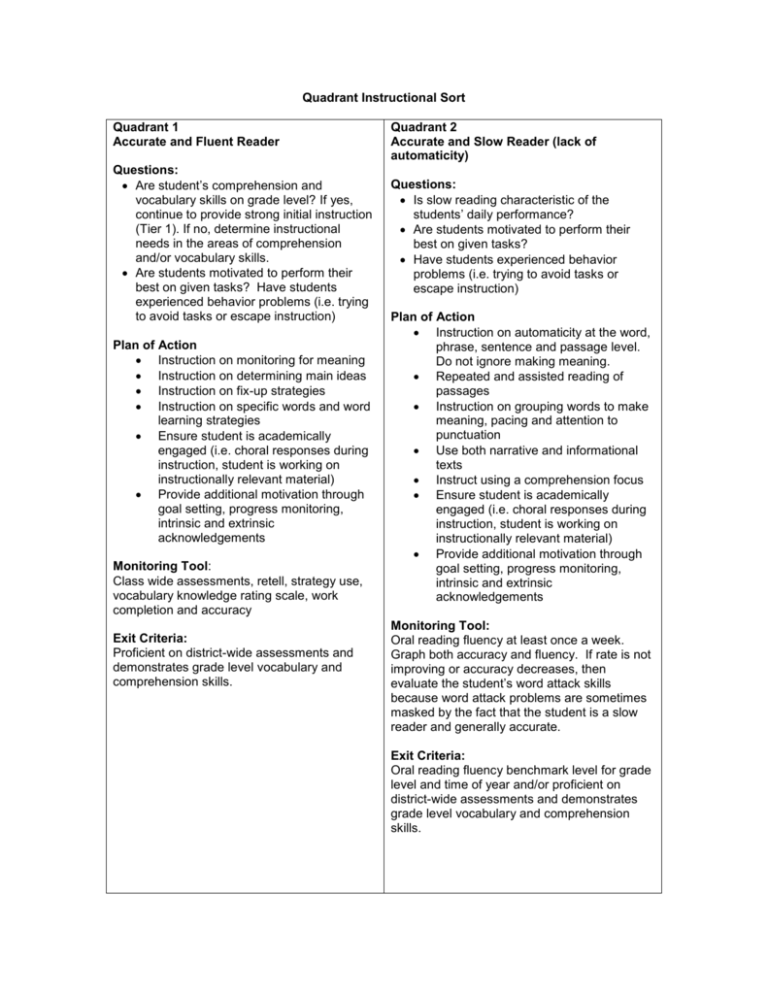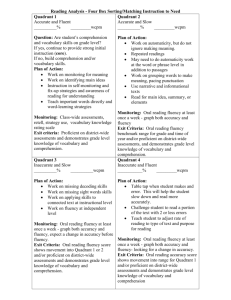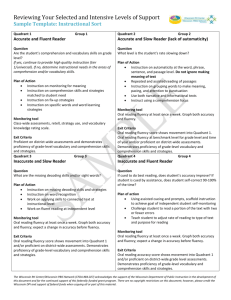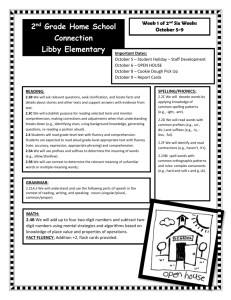ORF Quadrant Sort Directions
advertisement

Quadrant Instructional Sort Quadrant 1 Accurate and Fluent Reader Questions: Are student’s comprehension and vocabulary skills on grade level? If yes, continue to provide strong initial instruction (Tier 1). If no, determine instructional needs in the areas of comprehension and/or vocabulary skills. Are students motivated to perform their best on given tasks? Have students experienced behavior problems (i.e. trying to avoid tasks or escape instruction) Plan of Action Instruction on monitoring for meaning Instruction on determining main ideas Instruction on fix-up strategies Instruction on specific words and word learning strategies Ensure student is academically engaged (i.e. choral responses during instruction, student is working on instructionally relevant material) Provide additional motivation through goal setting, progress monitoring, intrinsic and extrinsic acknowledgements Monitoring Tool: Class wide assessments, retell, strategy use, vocabulary knowledge rating scale, work completion and accuracy Exit Criteria: Proficient on district-wide assessments and demonstrates grade level vocabulary and comprehension skills. Quadrant 2 Accurate and Slow Reader (lack of automaticity) Questions: Is slow reading characteristic of the students’ daily performance? Are students motivated to perform their best on given tasks? Have students experienced behavior problems (i.e. trying to avoid tasks or escape instruction) Plan of Action Instruction on automaticity at the word, phrase, sentence and passage level. Do not ignore making meaning. Repeated and assisted reading of passages Instruction on grouping words to make meaning, pacing and attention to punctuation Use both narrative and informational texts Instruct using a comprehension focus Ensure student is academically engaged (i.e. choral responses during instruction, student is working on instructionally relevant material) Provide additional motivation through goal setting, progress monitoring, intrinsic and extrinsic acknowledgements Monitoring Tool: Oral reading fluency at least once a week. Graph both accuracy and fluency. If rate is not improving or accuracy decreases, then evaluate the student’s word attack skills because word attack problems are sometimes masked by the fact that the student is a slow reader and generally accurate. Exit Criteria: Oral reading fluency benchmark level for grade level and time of year and/or proficient on district-wide assessments and demonstrates grade level vocabulary and comprehension skills. Quadrant 3 Inaccurate and Slow Reader Quadrant 4 Inaccurate and Fluent Reader Question: What are the missing decoding skills and/or sight words? Question: First thing to rule-out: Are students motivated to perform their best on given tasks? Have students experienced behavior problems (i.e. trying to avoid tasks or escape instruction) If cued to do best reading, does student’s accuracy improve? If student is cued by a table tap after each error, does student self-correct 90-100% of the time? Plan of Action Instruction on missing decoding skills Instruction on missing sight words Work on applying skills to connected text at instructional level Work on fluent reading at independent level Consider available evidenced base intervention programs to address the skill deficit areas. These are used for lower performing strategic level students and students with intensive needs. Are students motivated to perform their best on given tasks? Have students experienced behavior problems (i.e. trying to avoid tasks or escape instruction) Monitoring Tool: Oral reading fluency at least once a week. Graph both accuracy and fluency; expect a change in accuracy before fluency. Exit Criteria: Oral reading fluency score shows movement into Quadrant 1 or Quadrant 2 and/or proficient on district-wide assessments and demonstrates grade level vocabulary and comprehension skills. Plan of action: Table tap when student makes an error. This will help the student read more carefully and more accurately. Challenge student to read a portion of the text with 2 or less errors. Teach student to adjust rate of reading to type of text and purpose for reading Consider available evidenced base intervention programs to address the skill deficit areas. These are used for lower performing strategic level students and students with intensive needs. Are students motivated to perform their best on given tasks? Have students experienced behavior problems (i.e. trying to avoid tasks or escape instruction) Monitoring Tool: Oral reading fluency at least once a week. Graph both accuracy and fluency; expect a change in accuracy before fluency. If the strategies to encourage accuracy do not improve, consider further diagnostic assessments to determine instructional need. Exit Criteria: Oral reading accuracy score moves into range for Quadrant 1 and/or proficient on district-wide grade level knowledge of vocabulary and comprehension. Definition of Terms: Accurate: Student reads 95% or higher Innaccurate: Student reads below 95%








